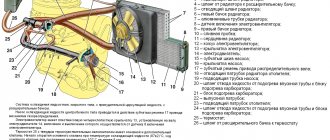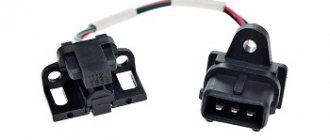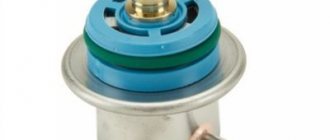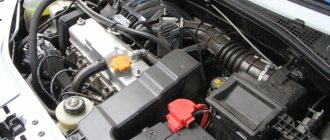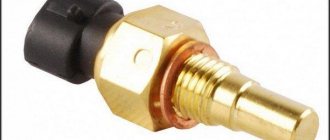In almost all modern cars, in addition to the sensor showing the engine temperature, there is another device that shows the temperature outside the car. The ambient temperature sensor in the car is part of the climate control system, as well as the on-board computer. Incoming information can be seen on the dashboard.
Don't worry about temperature error
The external thermometer displayed on the dashboard shows the outside temperature at any given time depending on the situation in which the car is located. If you continue driving on the highway for a long time, the temperature will drop, and if you park in a parking lot where the asphalt reflects heat and sunlight for a long time, the temperature will tend to rise.
It's best not to worry too much about the outside temperature and the error of plus or minus 3 degrees. However, if there is a significant deviation, such as 5 degrees or more, there is a possibility of sensor failure, so please carry out diagnosis. And remember that you don't need outside temperature values as a normal comfort function.
An outside air temperature sensor is built into your car so that you know what temperature is most comfortable to set in the cabin. Let us remind you that for an optimal climate in the cabin and more efficient fuel consumption, you should not set the air conditioner to too large a difference between the outside temperature and the temperature in the cabin. It is optimal when the difference is 3-5 degrees.
Conclusion
Many modern car enthusiasts naively believe that an external temperature sensor in a car is a completely useless option that is of little use. However, if you delve into the details, it becomes obvious that manufacturers simply would not equip vehicles with unnecessary features. Outside temperature sensors are aimed primarily at motorists who have to travel long distances in their cars and who do not have the opportunity to monitor weather conditions on the road using a smartphone or other gadget. Moreover, in some modern cars this device allows you to automatically select the optimal mode for the climate system, which in turn is aimed at the comfort of the driver and passengers.
“Lada Granta”: sensor installation
This car is equipped with a controller only in the maximum configuration. In other cases, there is preparation, that is, there are all the necessary connectors and wires for connection. This is done so that the driver has the opportunity to carry out the installation himself.
However, before installation, it is advisable to check whether the dashboard will display controller readings. To do this, press the daily mileage button and turn on the ignition. This is how we run self-diagnosis, as a result all indicators are displayed. During diagnostics, press the daily mileage button again, which should bring up version 090 or higher on the display. This will indicate the possibility of installing a sensor
Firmware for instrument cluster on Kalina2Granta
Since the USBDM programmer had already tested it at home (CAN recovery) and found out that it can also flash instrument clusters (gearboxes), I decided to flash it myself.
My gearbox costs 219240 and came with firmware 007 and did not display engine temperature readings. I decided to upgrade to version 009. But as always, the first thing is lumpy, an error popped up during the firmware and the result was a brick. Again, study the internet and figure out what’s wrong. I found my mistake, reflashed it with a new one - everything worked.
But the mileage readings became “000” and the IMMO was lost. There were no problems with retraining the keys (IMMO), the Internet is full of information, and I’ve already done it myself. But it was not easy to restore the mileage; the car is under warranty and also needs mileage. MrRararai for help
, he helped restore my mileage, for which I thank him very much.
Now I have firmware 012 on my gearbox.
Now I have also learned to change the mileage.
I surfed the Internet and this is what I found about instrument clusters:
how to view the CP firmware
- press the mileage switch button, then turn on the ignition without releasing the button (without starting the engine), the test will begin, press the button again - we see the software version (top line) and equipment (bottom line).
There are two firmware options:
1) with mileage and IMMO reset (it will be necessary to retrain the keys)
2) with preservation of mileage and IMMO.
— The gearbox seal is broken (warranty).
— When flashing the firmware, there must be a training key nearby, if something goes wrong and the IMMO is jammed, the car will not start, you need to train the keys (IMMO)
015
- on the old board, there is not a single temperature.
029 — 040
- updated board. there is no temperature.
All panels from the standard have a different display installed; to flash the firmware, you need to change it to a display from the standard. And add a bunch more elements. The old and new versions are different, each has its own improvements.
053, 060, 076, 087
- there is no temperature.
090, 091
– it is possible to connect an ambient temperature sensor (TOS), but there is no coolant temperature (TOZH)
092-095
– there is TOZ and TOS
053, 060, 076
– Old boards, to flash them you need to modify the board with a soldering iron or sew adapted 092 firmware
087-095
– New boards. Sewn without any modifications.
046
– has everything (same as 009 from Kalina)
009
– has everything (same as 046)
012
– everything is there, the latest version. It differs from 009 in the presence of a gear shift prompt.
Hardware PCs of configuration 40 (Lux) from configuration 20 (Normal) differ in the presence of an LED for indicating PPTF and the color of the glasses
— 219220(40)-007 and higher, there will be software: 009 or 012 — BC of the “Lux” configuration + engine temperature + removed the glitch with the outside air temperature + corrected the clock
On the 012 firmware of the gearbox and the firmware “i427ge05”, “i427GKA1” of the ECU, only on the luxury PC (219240), only on the manual (127 engine) - a hint about gear shifting appeared.
— 219020-060, 076 will be software: adapted 092, TOS and TOZH will be added
— 219020-087 and higher, there will be software: 092 or 046 (unlike 092, it will additionally show the engine operating time, fuel consumed and average speed. All parameters are resettable) or 009 from Kalina (in addition to 046, the squeak of the turn signals).
— 219040-032 and higher, there will be software: 046 — BC of the “Lux” configuration + engine temperature + removed the glitch with the outside air temperature + corrected the clock
Some data on firmware versions was taken from Goffka
Types of sensors that monitor coolant temperature
All sensors installed on modern cars are divided into magnetic and bimetallic. You can independently determine the specific type installed on your personal car by the speed of its reaction after starting the engine. The magnetic one has an instant response, and after starting the motor it immediately shows the current temperature. The bimetallic version does not differ in such “efficiency”, showing the correct temperature after a short pause.
The operating principle of a bimetallic (tape) sensor is quite simple. The existing control unit changes the current depending on the current temperature of the circulating fluid, which leads to heating of the coil on the metal strip. It is able to change its length according to the temperature, and rotate the arrow attached to it, showing the current temperature of the liquid.
The design of the magnetic sensor is also not complicated. It consists of an armature with an arrow attached to it, on the sides of which there are two coils powered from the on-board electrical network. The resistance of the coils changes depending on the passing current, and it is determined by the current temperature of the engine. There is another type of sensor - capillary. Currently, it is practically not used due to the inconvenience of the design.
Possible faults
Most often, temperature sensors located in the engine compartment, or, even worse, in the intake manifold, fail. When excessive heating occurs, at best, the intake air temperature sensor simply begins to “lie.” And sometimes it just collapses. In this case, it is important that fragments of the element do not fall into the engine.
In some cases, the temperature sensor may simply become covered with a thick layer of dirt. Here it will be enough to clean the element to restore its functionality.
A faulty sensor must be replaced with one of the same or similar properties. An incorrect replacement will, at best, produce errors. For example, there are known cases of replacing air temperature sensors with a liquid temperature sensor. The air temperature was also measured, but with very great inertia.
Where is the coolant temperature sensor located?
If installing an ambient air temperature sensor is not a priority, as is regularly checking its functionality, monitoring the coolant temperature is extremely important. To do this, the car is equipped with a special device that helps the driver constantly monitor the situation and prevent the engine from overheating.
A working sensor will allow you to turn off the vehicle’s engine in time, if there are prerequisites for overheating - this will prevent the onset of serious consequences associated with this. The location of the device itself may differ on different car models, but it will always “stand” on the path of fluid from the engine to the radiator:
It helps not only to avoid overheating. For example, at negative temperatures outside, this device will allow the driver to judge how warm the engine is. Naturally, you should not start driving on a supercooled engine, since this not only leads to a sharp increase in fuel consumption, but also seriously increases the percentage of engine wear. Information from the coolant temperature sensor will help you choose the “correct” engine warm-up mode, “telling” the driver whether to increase the idle speed.
What types of thermostats are there: what are they for, the principle of operation and the design of the device
A thermostat is a device that allows you to maintain the temperature within specified parameters.
Below you will learn how a thermostat works, how it works and the basic principle of its operation.
Without noticing this, we often come across a thermostat in life: it makes sure that the refrigerator maintains the desired temperature, does not overheat or freeze, thanks to it the kettle is heated to the desired temperature, and the car quickly warms up and does not break down due to the high engine temperature . You will learn why a thermostat is needed in different devices and what needs to be done to identify faults.
What is a thermostat and what is it for?
What is a thermostat and what is it for? Thermostat - what is it? A thermostat is a device that is needed to maintain the temperature at a given level.
It is used in different areas of life, in everyday life: to maintain the temperature in the stove, refrigerator, heated field, air conditioner. And in industry to regulate space heating, in cars the purpose of a thermostat is to avoid engine overheating.
Where is the temperature sensor installed?
Most often, such a useful device is mounted behind the radiator grille of a car or installed under the front bumper. Manufacturers thus minimize the risk of heat from the air conditioner or power unit of the car. In addition, this installation option allows you to protect the element from direct sunlight, under the influence of which the device may show unreliable readings. To prevent this component from heating up from the hot asphalt surface in the summer, it is mounted at a height of more than 30 cm from the road surface. With these important considerations in mind, manufacturers can place the temperature sensor in the most accessible location without having to install a lot of additional wiring. In practice, the exact placement of this device directly depends on the company that manufactured the car.
CHECKING THE AIR INTAKE TEMPERATURE SENSOR: TROUBLESHOOTING
SEARCHING FOR THE PROBLEM:
Intake sensor operation schedule
- Read fault memory ✓
- Check for proper connections, breaks and corrosion of the electrical connections of the sensor wiring, connector and sensor ✓
Test step 1
The internal resistance of the sensor is determined. Resistance depends on temperature. When the motor is cold it is high impedance and when the motor is hot it is low impedance.
Depending on manufacturer: 25°C 2.0 - 6 kOhm or 80°C approx.
300 ohms Please note the special characteristics of the reference value.2
Test step 2
Check the wiring to the control unit, checking for continuity and short to frame for each wire to the control unit connector.
- Connect an ohmmeter between the temperature sensor plug and the removed plug of the control unit. Reference value: approx. 0 Ohm (requires pin assignment diagram on control unit).
- Check the corresponding contact on the sensor plug relative to ground using an ohmmeter and remove the control unit plug. Reference value: >30 MΩ.
Test step 3
Check the supply voltage at the removed sensor plug using a voltmeter. This is done with the control unit connected and the ignition on. Reference value: approximately 5V.
If the voltage value is not reached, it is necessary to check the supply voltage of the control unit and grounding in accordance with the circuit diagram. If everything is fine, a control unit error occurs.
How to extend the life of the controller
The cost of this device is relatively small. If the sensor fails, it is better to replace it with a new one. Experienced mechanics advise doing this. You can try to extend its service life, but there is no guarantee that the DTNV will not fail at the most inopportune moment.
In any case, before replacing the controller, it is best to ensure the following:
- If the contacts are oxidized, they should be cleaned.
- Oxidized contacts on the chip should be wiped with alcohol and dried.
- Check wiring.
What is needed to determine a sensor malfunction
Unfortunately, like any other mechanism in a car, the outside temperature sensor can fail over time, after which unreliable information will be displayed on the dashboard. As for the exact data, it is available in the morning at a time when the vehicle has not yet warmed up, and in addition, a working device is installed on the car. If the motorist begins to notice that this component shows inaccurate information, then, most likely, replacement is required, however, before doing this, it is worth checking the device for functionality. To do this, you do not need to go to a service center, for the simple reason that you can do everything necessary yourself.
As a rule, the process of checking the outside temperature sensor consists of the following series of fairly simple and sequential actions on the part of the motorist:
- Initially, you need to compare the readings of the sensor, as well as a regular thermometer installed outside the window;
- information from different devices should be approximately the same (an error of one degree is allowed);
- Next, you need to start the engine in the car, warm it up, and also drive it for a distance of a couple of kilometers;
- if during the trip the readings on the instrument panel change periodically, then most likely moisture has entered the sensor housing;
- As a rule, moisture gets into the temperature sensor housing when this element is installed incorrectly;
- if moisture is actually to blame, then after stopping the car the device will need to be dismantled, removed from the casing and wiped;
- The clean component should be returned to its original place, and then connected to power.
If after these manipulations the readings still do not correspond to reality, it will be easier to purchase a new device and replace the air temperature sensor outside the car.
Signs of malfunction and replacement
p, blockquote 28,0,0,0,0 —>
The main symptom of a malfunctioning outside air temperature sensor is incorrect readings. The easiest way is to check the temperature readings in the morning, when the car is still cold; it cannot introduce an error into the measurements. You need to look at the temperature on the thermometer outside the window, then go down to the car, turn on the ignition and check the readings in the car. If you do not live on the 20th floor, then the readings of both thermometers should be approximately the same.
p, blockquote 29,0,0,0,0 —> adsp-pro-12 —>
Next, you should start the engine, warm it up, and drive 2-3 kilometers, measuring the outside temperature. If the temperature “floats”, it is possible that dirt or debris has entered the sensor. It is necessary to turn off the ignition in a garage or parking lot, remove the sensor connector, and dismantle it. Next, you need to remove it from the case, inspect the condition, and if dirty, wipe it with a soft cloth soaked in a non-aggressive solvent.
p, blockquote 30,0,0,0,0 —>
You can check the resistance of the sensor at different temperatures using a multimeter, but to do this you need to know the reference values. They are difficult to find on the Internet. You can use special reference books.
p, blockquote 31,0,0,0,0 —>
You can view and select inexpensive outside air temperature sensors for different car models HERE.
In some cases, it is easier to buy a new one; it is relatively inexpensive. The new sensor must be from this particular car model. It's easy to connect and install. The next day after connection, you can evaluate the accuracy of its readings, as described above.
p, blockquote 33,0,0,0,0 —>
What is the purpose of the inlet air temperature sensor?
Another temperature sensor that any vehicle is equipped with is the intake air temperature sensor. At first glance, its role is quite insignificant, and most motorists may not even be aware of its existence. In fact, the uninterrupted operation of the car engine largely depends on the performance of this unit. Most modern temperature sensors are designed based on a semiconductor thermistor, so there are practically no problems during operation.
If difficulties arise, as a rule, they are as follows. During long-term operation, there is a discrepancy between the temperature readings on the sensor body and its electrical resistance. This leads to a smaller error in calculating the actual temperature of the incoming air. As a result, the computer, which calculates the parameters of the fuel mixture, sharply reduces the air supply and at the same time increases the “portion” of fuel. The resulting mixture entering the cylinders is “incomplete,” which makes its combustion process difficult. This results in unstable engine operation; in addition, an overly enriched mixture easily causes spark plugs to flood, which makes starting the engine impossible.
There are no recommendations regarding the frequency of checking this sensor, and each car owner decides for himself
To independently check the functionality of this important incoming air temperature sensor, you will need an ohmmeter and a table with normal resistance values, which is included in the instructions for the car itself. The test begins with the engine cold and continues with the engine running until the cooling fan starts. If there is reason to believe that the sensor is faulty, it makes sense to replace it with a new one
The cost of the device is low, and all replacement work is completed in a matter of minutes and does not require special skills or experience
If there is reason to believe that the sensor is faulty, it makes sense to replace it with a new one. The cost of the device is low, and all replacement work is completed in a matter of minutes and does not require special skills or experience.
An external air temperature sensor (ATS) is installed on cars to ensure driver comfort.
AvtoVAZ specialists began to include an external air temperature sensor in the car’s on-board computer. It is included in the standard equipment of the VAZ-2110. The fifteenth model already has a VDO dashboard with two windows and a temperature display on the display.
Various options for installing DTVV on a VAZ-2110 car are widely used. The most suitable sensor for this model is the one with catalog number 2115-3828210-03 and the cost is around 250 rubles. Its serviceability is usually checked using a test: when the part is cooled and heated, the current resistance indicators change.
DTVV must be insulated from moisture, and direct sunlight must also be prevented. The sensor must be protected from heat coming from the vehicle's engine compartment. Therefore, the most suitable location for mounting the device is at the front of the vehicle or in the immediate vicinity of the towing eye.
The sensor itself is equipped with a pair of contacts: one of them is directed to ground, and the second gives a signal about a change in temperature. The last contact is made into the car interior through a hole next to the fuse box. The VAZ-2110 is equipped with on-board computers in two versions: MK-212 or AMK-211001.
In such on-board computers, the second contact of the sensor must be connected to C4 on the MK block. In this case, I take out the outgoing free wire and then carefully insulate it.
If the DTVV is not connected correctly or there is an open circuit, the following will be displayed on the on-board computer display: “- -”.
It is quite easy to connect DTVV to a VAZ-2115, since this car is equipped with a VDO panel with two displays.
The sensor wire is attached to the red block X2 in socket No. 1 on the car’s dashboard.
Is there an error in the outside air temperature sensor?
In most modern cars, in addition to engine temperature, you can now find another temperature indicator. It's about the temperature outside
Have you noticed that sometimes the temperature shown on the dashboard or infotainment display changes suddenly? Have you ever thought about the veracity of this temperature? Do you know where the external thermometer is located in the car? The online publication 1gai.ru explains the mystery of the outside air temperature sensor in a car.
The outside air temperature sensor is often located at the rear of the front bumper.
The outside temperature sensor of the Prius is located just behind the license plate, inside the bumper, about 30 cm from the ground.
First, let's find out where the temperature sensor that measures the outside air temperature is most often installed.
Let's take cars like Toyota as an example.
For example, on Toyota Prius and Toyota Aqua vehicles, the temperature sensor is located at the lower end of the front bumper panel, below the end of the radiator, about 30 cm from the ground towards the outer peripheral grille. In the Toyota Sienta, the sensor is located in almost the same place: in the lower right part of the front radiator grille, at a height of 30 cm from the ground, only, unlike the Toyota Prius and Toyota Aqua, it is shifted to the right.
In the case of Toyota cars, there is not much difference in the mounting position of the temperature sensor, no matter what model we are talking about (sedans, hybrids, SUVs, etc.). Almost always, this auto component is mainly installed between the inside of the front grille and the radiator
Note the air temperature sensor on the right side of the bumper, around the inside
Since the air temperature sensor is located close to the engine compartment, it is likely affected by engine heat. But in fact, such sensors are located in such a way that the outside air has a sufficient influence on them.
For example, when the vehicle is in motion, the influence of engine heat is minimal because the temperature sensor is exposed to the environment. That is, this sensor is designed to monitor the outside air temperature only when the car is in motion. When a car stands still for a long time with the engine running, the air temperature readings may differ significantly from the actual value.
What about, for example, Volkswagen cars? In response to our request, a company representative replied that basically all cars of the brand have an air temperature sensor in the rear of the front bumper.
By the way, thanks to this sensor, Volkswagen cars have a warning system for the formation of ice on the street. For those who do not know, let us remind you that this is a driver warning system that informs about the danger of freezing the road surface. Typically, when the temperature drops to 4 degrees Celsius, a warning tone sounds in the car and an ice warning appears on the dashboard display (depending on the type of vehicle).
By the way, an alarm is issued, for example, when the temperature with a minus value rises above zero degrees, but does not exceed 4 degrees Celsius. But as soon as the outside air temperature rises above 4 degrees, the road frost warning system stops informing the driver of the danger.
General information
As noted above, various sensors are installed on cars for a reason. They are necessary for the efficient operation of the system as a whole. As for the outside air temperature controller, it is mostly informational in nature and shows the temperature outside. But this does not apply to all systems. Sometimes the coolant temperature sensor is connected to the engine electronic systems. This is necessary to start the engine in the cold season and is a very convenient addition to the “autostart” function.
Unfortunately, not all cars have a temperature sensor built in at the factory. Many VAZ models do not provide this. But it doesn’t matter, let’s look at how to install it and what is remarkable about this process.
Self-installation of outside air temperature sensor
Many VAZ car models do not have an air temperature sensor, so to increase comfort, many car enthusiasts install it themselves. This does not require any special skills, but first you should determine whether the dashboard is able to identify the readings of the new device. This is not difficult to do, and, for example, on Grant it is done as follows:
If the version supports the ability to connect a temperature sensor, you can go to the auto store to purchase it and begin the installation process. Initially, you should correctly determine the location of the outside air sensor - it should not be influenced by temperature flows from the engine. The optimal place is considered to be the space close to the radiator - it can be seen when the hood is open, there is a pin welded to the frame. It is convenient to “throw” the mass from the device onto it.
After securing the device itself, you will need to run a “plus” wire into the interior. To do this, you can use the clutch cable plug or another convenient place. After this, you will need to remove the instrument panel; you need to find the 25th contact, intended specifically for the temperature “controller” of the ambient air. The “outboard” temperature readings appear automatically in the menu. If this does not happen, the positive terminal is removed from the battery for 10 minutes. After power is restored, the temperature will appear. The installation process can be seen in the video:
About installing the controller on Kalina
Let's figure out how to install an ambient temperature sensor on this car. "Kalina", unfortunately, often does not even have the necessary wires, so you will have to pull them into the cabin yourself.
To install, you need to remove the bumper and install the sensor, preferably in front of the radiator. There are only two wires - ground and signal. We hook the mass to the nearest bolt, for example from a horn. We tape the signal wire to the harness with tape, although it is more preferable to use plastic clamps. The most convenient way to bring it into the cabin is through a plug installed near the battery. We remove the tidy and connect the sensor. Usually it shows the temperature right away, you don’t even have to remove the terminals. Now you know where the ambient temperature sensor is located on VAZ cars.
How to choose a temperature sensor
In order for this component in the car to work properly, it is necessary to choose the right device, guided by some recommendations from experts, namely:
- you should choose a device based on the make and model of the car;
- in the selection process, you should abandon the cheapest options;
- It is recommended to buy an original sensor or a high-quality analogue;
- It is also necessary to compare the old element with the new device, since completely different devices can be installed on the same cars in different years in terms of the type of fastening or connection.
In such a situation, the manufacturer recommends choosing the original part; however, you can use a cheaper analogue, but only from a proven and reliable company.

